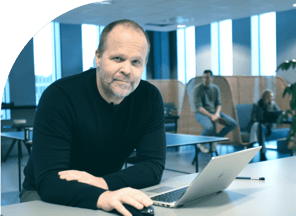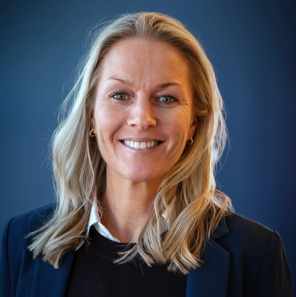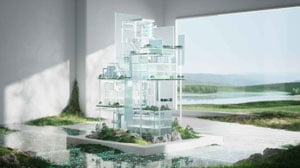So what is a digital twin, anyway, and why should I be using one?
As projects and assets become more and more complex, our ability to manage and maintain them must improve correspondingly. We think the best way to do so, is by using a digital twin. A digital twin is a comprehensive information model of any physical asset, be it a wind turbine, a hydrogen plant, or even an oil rig – any physical object you can think of. Forget blueprints, intricate drawings, and paperwork. A well thought-out digital twin will help you uncover all the information you need, from fine-grained details to intuitive overviews, and – just like your actual better half – gently, but firmly, guide you towards making the right decisions.
From concept to operations
When building a digital twin, you create a virtual replica of your asset which evolves over time. It is able to represent your asset over its entire lifetime, from being a set of concepts (yes, more than one), through being designed in ever greater detail, into being built and tested, and finally mirroring its actual counterpart throughout its operational life. All the while it offers the best available representation of the state of your asset, the history of how it got to the where it is now, and also several views of how it might evolve, based on decisions that you get to make. Not bad for a model, wouldn’t you a agree?
Once your asset goes into production, you will hook the twin up to real-time data sources ranging from control system data, through all manners of sensor data, like camera feeds, available to the users and organisations you choose.
“The promise of an operational digital twin might seem unworkable, but the confluence of semantic information modelling, automated information ingestion pipelines, scalable storage and compute, rich collaboration features, and device-aware 3d rendering, will make digital twins pervasive over the next few years. The only question is, who will get there first,” says Frode Strand, CTO of Aize.

Actual benefits of a digital twin
So what actually changes if I get to use a digital twin?
Primarily, everyone will have access to the same information, down to some level of detail. That means spending less time managing coordination and communication between teams, partners, and stakeholders, and more time spent discussing (and hopefully resolving!) issues, which are still going to be there, but will be brought to everyone’s attention much quicker.
Secondly, you will lower the friction and improve the logistics of evolving all the information that the design, building and testing of your asset requires. Revision control of documents will be replaced by looking at a selected scope in the digital twin, and formal change control will gradually be replaced by tagging relevant parts of the chat threads and tying them to the change history of the relevant objects.
Face-to-face-meetings to review design issues will be replaced by everyone leaving their comments directly in the twin, and the responsible party being able to make well-founded recommendations, which can be approved in a video meeting where everyone is looking at the twin in real time.
And thirdly, you will have a foundation for continuously improving. With multiple sensors on your physical asset mirrored to your digital twin, you will have access to vast amounts of both live and historical data. Accompanied by the software to make sense of it, vasts amounts of data that are daunting for the human brain to handle, can be tackled by any means appropriate, such as machine learning or algorithms in the digital twin. By taking note of what happened yesterday, last week and last year, the digital twin uses your data to decide the best course of action and even predict what might happen down the road. Your digital twin will be your very own powerhouse for learning, leaving you with less guesswork and better precision.
Is there a cost to be paid for all this goodness?
Of course there is.
You’re going to have to determine what data to fill your twin with (which will highlight issues that you probably already have regarding who ‘owns’ which data), set up data pipelines to actually get the data on a timely basis (which will have you grappling with IT), and on top of everything, the quality of your data will be exposed to everyone involved (which will lead to discussions on the various risks of exposing data to your customers, partners and vendors).
Oh, and by the way, once your users get used to having the twin around, be prepared for every Tom, Dick and Harry not only asking for access, but requesting features en masse. Nothing in the known universe increases more quickly than user expectations.
But guess what – it’s still worth it.

Industry of the future: An ecosystem of digital twins
It is a feature of the world that once a new tech capability becomes available, a swarm of users descend on the new tools to try them out and compete for glory. So too will be the case with digital twins, and we’re seeing the signs already: information architects, tech-interested information managers, asset owners, and standards bodies are hard at work creating asset data models, which they hope will sit atop whatever data lake is available in their respective companies.
So where does this lead to, and how fast are we getting there? Well, we think that every physical asset will be not only accompanied by, but in most cases driven by its digital twin, and we think that future is being shaped now. Depending on where you want to place yourself and your company on the adoption curve, you should already be talking to us, or you may choose to wait and see how things play out. Either way, reality is dual – your asset is two, not one.
Want to take part to this exciting journey?

Post written by Trine Bratt Stølsnes
Trine is the Director and Head of Marketing at Aize, where she combines her passion for marketing strategy with the challenge of shaping how digital twin technology transforms the energy industry. With years of experience in B2B marketing, she is dedicated to driving meaningful change through effective marketing and communication.
Stay in the loop
I’d like to sign up to Aize newsletter



